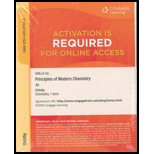
Concept explainers
a)
Interpretation: The ionization energy of molecular hydrogen is greater than atomic hydrogen should be explained. Also, the ionization energy of molecular oxygen is lower than atomic oxygen should be explained.
Concept introduction: Two or more than two atomic orbitals overlap to form bond, these orbitals are called molecular orbitals. Count of molecular orbital obtained is same as count of atomic orbitals mixed.
Two forms of molecular orbital are obtained. These are bonding and antibonding orbital.
Bonding orbitals are those in that electrons are in between nucleus of two atom. Antibonding orbitals are those in which electrons are away from nucleus of two-atom. Also, electrons in antibonding orbital have energy high as compared to bonding orbital.
In sigma
In pi
In pi
b)
Interpretation: The relative ionization energies of atomic and molecular fluorine should be determined.
Concept introduction: Two or more than two atomic orbitals overlap to form bond, these orbitals are called molecular orbitals. Count of molecular orbital obtained is same as count of atomic orbitals mixed.
Two forms of molecular orbital are obtained. These are bonding and antibonding orbital.
Bonding orbitals are those in that electrons are in between nucleus of two atom. Antibonding orbitals are those in which electrons are away from nucleus of two-atom. Also, electrons in antibonding orbital have energy high as compared to bonding orbital.
In sigma
In pi
In pi
Want to see the full answer?
Check out a sample textbook solution
Chapter 6 Solutions
PRINCIPLES OF MODERN CHEMISTRY-OWLV2
- Label the spectrum with spectroscopyarrow_forwardQ1: Draw the most stable and the least stable Newman projections about the C2-C3 bond for each of the following isomers (A-C). Are the barriers to rotation identical for enantiomers A and B? How about the diastereomers (A versus C or B versus C)? enantiomers H Br H Br (S) CH3 H3C (S) (R) CH3 H3C H Br A Br H C H Br H3C (R) B (R)CH3 H Br H Br H3C (R) (S) CH3 Br H D identicalarrow_forwardLabel the spectrumarrow_forward
 Chemistry & Chemical ReactivityChemistryISBN:9781337399074Author:John C. Kotz, Paul M. Treichel, John Townsend, David TreichelPublisher:Cengage Learning
Chemistry & Chemical ReactivityChemistryISBN:9781337399074Author:John C. Kotz, Paul M. Treichel, John Townsend, David TreichelPublisher:Cengage Learning
